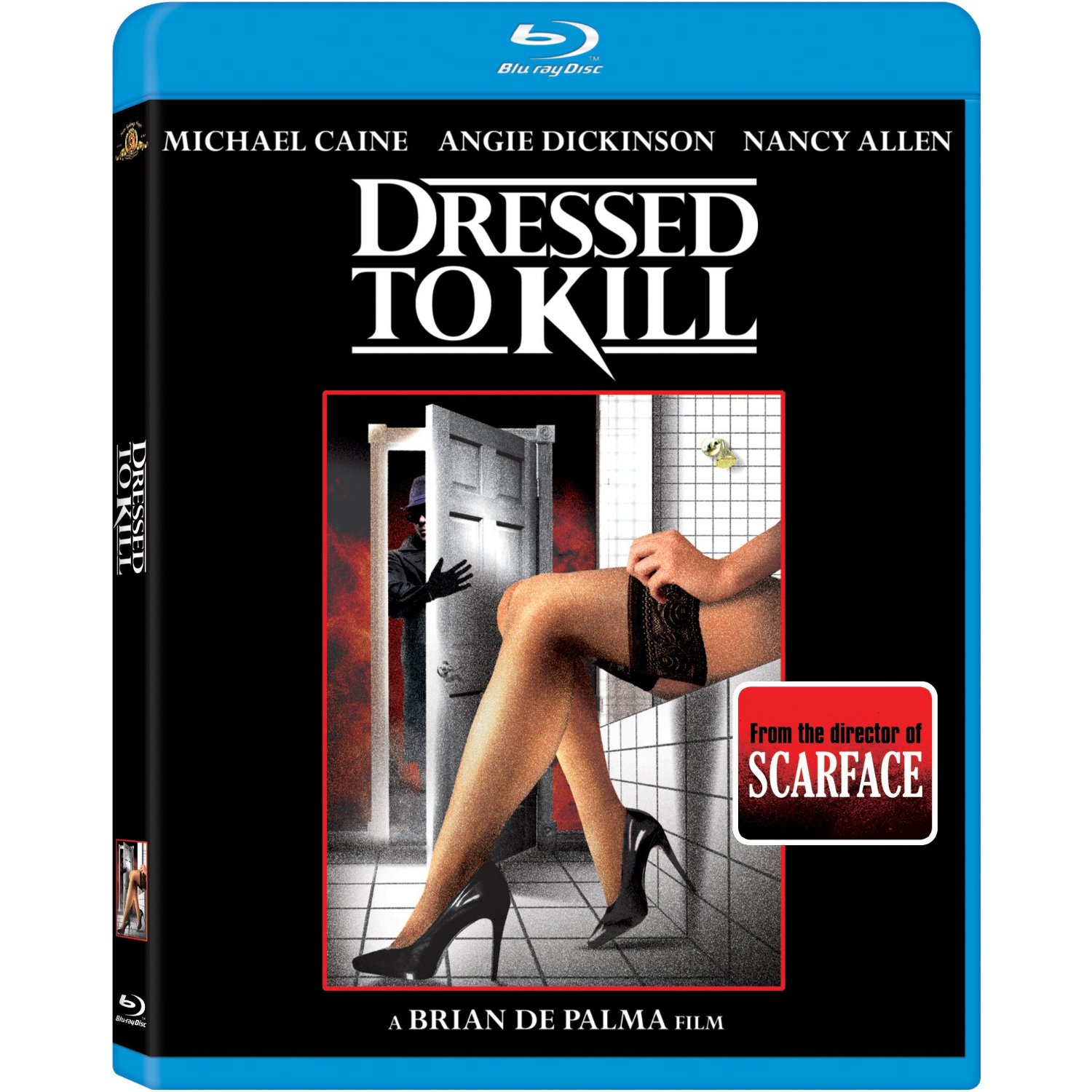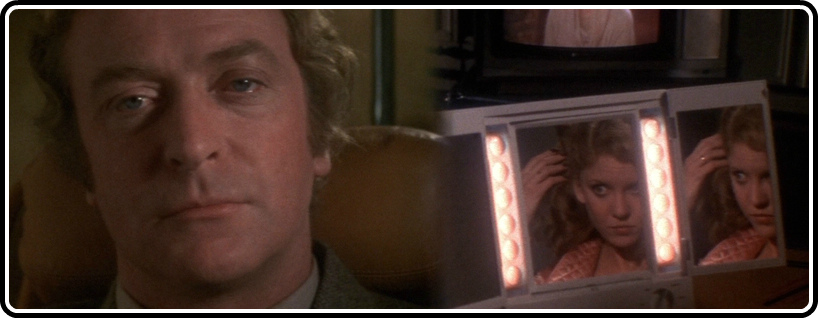Following his ‘Carrie-lite’ The Fury in 1978 and his comedy Home Movies the same year as the film that will be reviewed, he came back to the thriller genre he hadn’t fully delved into since 1976 with Obsession with his giallo homage Dressed to Kill, starring Michael Caine, Nancy Allen and Angie Dickenson. Did he return to the heights of his earlier thrillers (such as Criterion film Sisters) or should you just buy his following film Blow Out instead?
Kate (Angie Dickenson) is in a loveless, sexless marriage and wants to find something more exciting in New York City. She goes to a psychologist, Dr. Elliot (Michael Caine), and tells him as much while also attempting to seduce him. He kindly turns her down, even though he is attracted, because he’s married and has ethics in his profession. She plans a day at the Metropolitan Museum of Art with her son Peter (Keith Gordon) but he’s been working on something very important for school and is a bit of a computer whiz. She lets him off the hook and goes without him where she starts up a silent flirtatious cat and mouse escapade throughout the museum with a man. When one of her gloves goes missing, she decides to throw away her single glove but sees the man in a taxi. They decide to take the opportunity for some afternoon delight, going off with the man and having more intense sex in the taxi itself than she has had for awhile.
In the middle of the night she wakes up, walks around the guy’s apartment and decides to write him a note before she leaves. When she finds a hospital letter saying he was diagnosed with a couple of sexually transmitted diseases, she leaves abruptly and forgets her watch and wedding ring. As she goes back up to the apartment, the elevator opens to a blonde woman holding a straight razor, who proceeds to cut up Kate viciously with no rhyme or reason whatsoever. The only witness to the crime is a high class prostitute, Liz Blake (Nancy Allen), who becomes the chief suspect when Detective Marino (Dennis Farina, who I recently realized has always played a cop, a sleaze or a sleazy cop) has no other leads. Dr. Elliot has also been getting calls from a former patient, Bobbi, has become enraged that he wouldn’t agree to his gender reassignment surgery and mentions taking his straight razor and using it on a ‘blonde whore’ and to watch the news. While this is all going on, Peter has started his own investigation to find out who killed his mother.
This is a film that one must walk a fine line between giving some plot details and then hiding the rest from view. This is a film that must be watched with as little information going into because knowing one or two things will completely ruin it for the audience. Even if I mention a film or two that this film references or definitely outright borrows a bit of a twist from will give it away, so I’ll shy away from all that. What can be done is mention some things that put this film above most other thrillers, during this time and much after. Split screens are done throughout the film, but in some ways differently than he’s done before. A split screen within a split screen, especially when we see Dr. Eliot watching a news program about trans people all while Liz is watching the same program, split into two for us to view. We also get a daring 10 minute silent scene between Dickenson’s Kate and the mysterious pick up artist at the museum, the music of Pino Donaggio (a constant collaborator) telling us this story, at first flirty, then a bit frightening, back to playful, yearning and finally sadness due to the belief that something was lost. It’s an amazing scene and when we finally hear Kate’s voice again, we realize we hadn’t heard anything but music and sound effects for that period of the film.
Another scene worth mentioning, which also feels like a slight nod to both Fulci’s A Lizard In a Woman’s Skin and Friedkin’s The French Connection, is when Liz is on a subway platform, on the run from this crazed sunglasses wearing killer, all while trying to hide and angering a group of street toughs and even a cop who doesn’t quite believe her. It’s a tense scene, with the killer, this cop and also this group of angry hooligans who seem to all be gunning for her. Living in New York City alone makes this a harrowing scene, let alone anyone else who has ever imagined worse case scenarios when on a subway car. And when this scene finally ends the way it does, the air is just knocked right out of us and we still have plenty of film left. The only thing I will say without giving anything away is that even though the ending is done rather well, it’s still a bit of a letdown. I know that doesn’t tell you much, but it’s something that’s truly bugged me since I first saw it. Email me if you’d like to speak more about it.
For awhile when I started the For Criterion Consideration series of articles, I was planning on doing a whole Brian De Palma series. I’ve done one already (Phantom of the Paradise) but I had envisioned another to pop up as the intro to the series. It was to be the film here, Dressed To Kill. It was a film that I thought was sorely looked over when speaking about early slasher films and also a great nod to the gialli films that Mario Bava, Dario Argento, Lucio Fulci (before his gore fests) and various other Italian filmmakers were churning out since the 1960’s. I point this out because most people, especially critics of that time, were calling De Palma a ‘Hitchcock wannabe’, which I always felt was such a negative dig at the director. He even cites Hitchcock as one of his biggest influences, his films also being considered giallo by Italian directors and film goers, due to their beautiful women, murderer in the shadows (sometimes with leather gloves) and tense pace that makes your heart race when done properly.
MGM Home Video gives us a nice looking transfer, nothing breathtaking but definitely a step up in the right direction, and the same release as the former DVD release that came out a few years back. Glad to see one special feature came back, which is The Making of a Thriller Documentary, an extensive 43 minute featurette about the making of the film, with Brian De Palman, Angie Dickenson, Nancy Allen, Keith Gordon and other detailing the making of this film. We also get A Film Comparison – The 3 Versions of Dressed to Kill which is a 5 minute comparison piece of a few select scenes showcasing the differences in editing. Slashing Dressed to Kill talks about what changes had to be made to the film to avoid an X rating. Dressed to Kill: An Appreciation by Keith Gordon is just that, Gordon speaking more about his appreciation of working with De Palma and how it helped his career. And finally you get a photo gallery and the original theatrical trailer.
Considering two De Palma films came out on Blu-ray recently, most went for his crime film, Scarface. While a fun film, it is De Palma showing he could hang with the big leagues, especially from a script by up and comer Oliver Stone. Is it De Palma’s best film? Not at all. I personally hold Dressed to Kill above it and suggest to people to check this one out on Blu-ray, because it hasn’t looked this good in quite awhile. Definitely do a double feature of this film and Criterion’s recent Blu-ray release for Blow Out. You can just call it the Nancy Allen call girl double feature, which she’s fantastic in both. It’s just fun to think that she and De Palma were married at this time. Buy this film now if you haven’t seen it or want to upgrade. It’s definitely worth it.






![Bergman Island (The Criterion Collection) [Blu-ray]](https://criterioncast.com/wp-content/uploads/2022/11/bergman-island-the-criterion-collection-blu-ray-400x496.jpg)
![This Is Not a Burial, It’s a Resurrection (The Criterion Collection) [Blu-ray]](https://criterioncast.com/wp-content/uploads/2022/11/this-is-not-a-burial-its-a-resurrection-the-criterion-collection-blu-ray-400x496.jpg)
![Lars von Trier's Europe Trilogy (The Criterion Collection) [The Element of Crime/Epidemic/Europa] [Blu-ray]](https://criterioncast.com/wp-content/uploads/2022/11/lars-von-triers-europe-trilogy-the-criterion-collection-the-element-of-400x496.jpg)
![Imitation of Life (The Criterion Collection) [Blu-ray]](https://criterioncast.com/wp-content/uploads/2022/11/imitation-of-life-the-criterion-collection-blu-ray-400x496.jpg)
![The Adventures of Baron Munchausen (The Criterion Collection) [4K UHD]](https://criterioncast.com/wp-content/uploads/2022/11/the-adventures-of-baron-munchausen-the-criterion-collection-4k-uhd-400x496.jpg)
![Cooley High [Criterion Collection] [Blu-ray] [1975]](https://criterioncast.com/wp-content/uploads/2022/11/cooley-high-criterion-collection-blu-ray-1975-400x496.jpg)